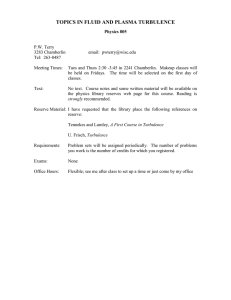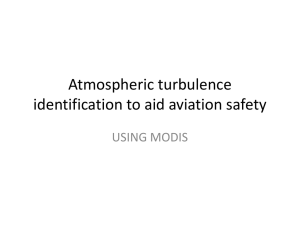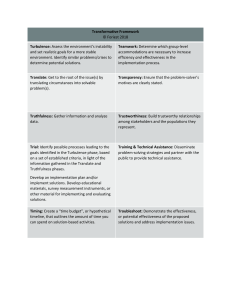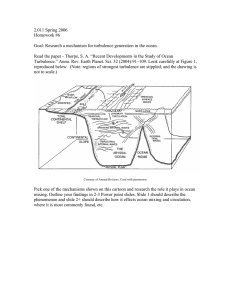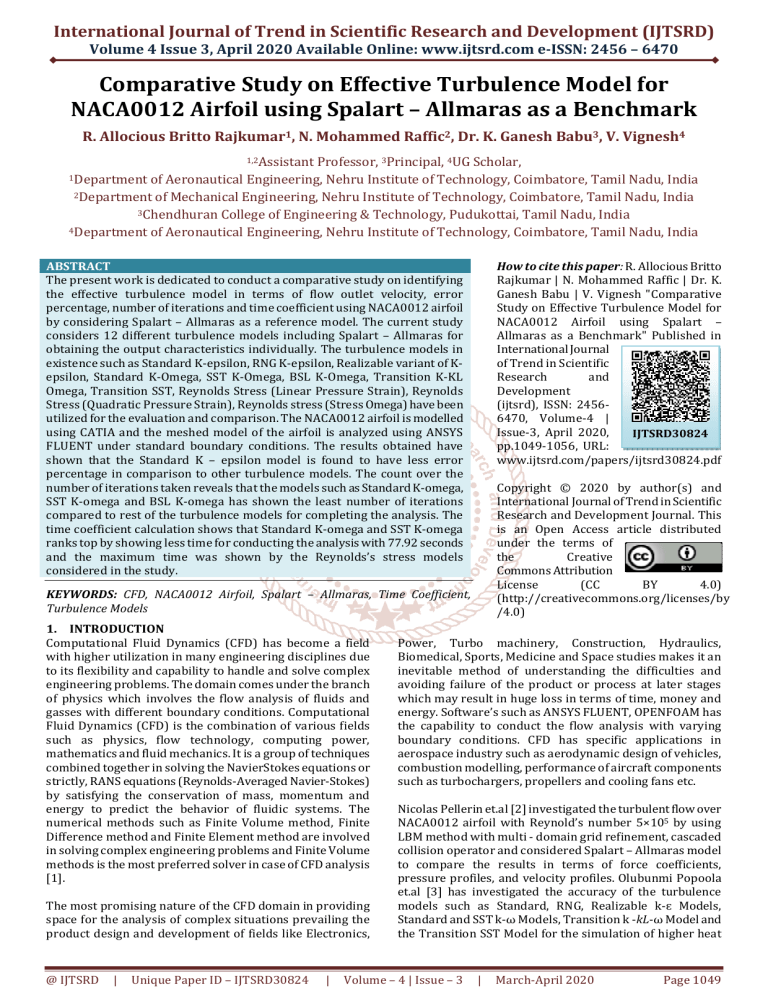
International Journal of Trend in Scientific Research and Development (IJTSRD)
Volume 4 Issue 3, April 2020 Available Online: www.ijtsrd.com e-ISSN: 2456 – 6470
Comparative Study on Effective Turbulence Model for
NACA0012 Airfoil using Spalart – Allmaras as a Benchmark
R. Allocious Britto Rajkumar1, N. Mohammed Raffic2, Dr. K. Ganesh Babu3, V. Vignesh4
1,2Assistant
Professor, 3Principal, 4UG Scholar,
1Department of Aeronautical Engineering, Nehru Institute of Technology, Coimbatore, Tamil Nadu, India
2Department of Mechanical Engineering, Nehru Institute of Technology, Coimbatore, Tamil Nadu, India
3Chendhuran College of Engineering & Technology, Pudukottai, Tamil Nadu, India
4Department of Aeronautical Engineering, Nehru Institute of Technology, Coimbatore, Tamil Nadu, India
How to cite this paper: R. Allocious Britto
Rajkumar | N. Mohammed Raffic | Dr. K.
Ganesh Babu | V. Vignesh "Comparative
Study on Effective Turbulence Model for
NACA0012 Airfoil using Spalart –
Allmaras as a Benchmark" Published in
International Journal
of Trend in Scientific
Research
and
Development
(ijtsrd), ISSN: 24566470, Volume-4 |
Issue-3, April 2020,
IJTSRD30824
pp.1049-1056, URL:
www.ijtsrd.com/papers/ijtsrd30824.pdf
ABSTRACT
The present work is dedicated to conduct a comparative study on identifying
the effective turbulence model in terms of flow outlet velocity, error
percentage, number of iterations and time coefficient using NACA0012 airfoil
by considering Spalart – Allmaras as a reference model. The current study
considers 12 different turbulence models including Spalart – Allmaras for
obtaining the output characteristics individually. The turbulence models in
existence such as Standard K-epsilon, RNG K-epsilon, Realizable variant of Kepsilon, Standard K-Omega, SST K-Omega, BSL K-Omega, Transition K-KL
Omega, Transition SST, Reynolds Stress (Linear Pressure Strain), Reynolds
Stress (Quadratic Pressure Strain), Reynolds stress (Stress Omega) have been
utilized for the evaluation and comparison. The NACA0012 airfoil is modelled
using CATIA and the meshed model of the airfoil is analyzed using ANSYS
FLUENT under standard boundary conditions. The results obtained have
shown that the Standard K – epsilon model is found to have less error
percentage in comparison to other turbulence models. The count over the
number of iterations taken reveals that the models such as Standard K-omega,
SST K-omega and BSL K-omega has shown the least number of iterations
compared to rest of the turbulence models for completing the analysis. The
time coefficient calculation shows that Standard K-omega and SST K-omega
ranks top by showing less time for conducting the analysis with 77.92 seconds
and the maximum time was shown by the Reynolds’s stress models
considered in the study.
Copyright © 2020 by author(s) and
International Journal of Trend in Scientific
Research and Development Journal. This
is an Open Access article distributed
under the terms of
the
Creative
Commons Attribution
License
(CC
BY
4.0)
(http://creativecommons.org/licenses/by
/4.0)
KEYWORDS: CFD, NACA0012 Airfoil, Spalart – Allmaras, Time Coefficient,
Turbulence Models
1. INTRODUCTION
Computational Fluid Dynamics (CFD) has become a field
with higher utilization in many engineering disciplines due
to its flexibility and capability to handle and solve complex
engineering problems. The domain comes under the branch
of physics which involves the flow analysis of fluids and
gasses with different boundary conditions. Computational
Fluid Dynamics (CFD) is the combination of various fields
such as physics, flow technology, computing power,
mathematics and fluid mechanics. It is a group of techniques
combined together in solving the NavierStokes equations or
strictly, RANS equations (Reynolds-Averaged Navier-Stokes)
by satisfying the conservation of mass, momentum and
energy to predict the behavior of fluidic systems. The
numerical methods such as Finite Volume method, Finite
Difference method and Finite Element method are involved
in solving complex engineering problems and Finite Volume
methods is the most preferred solver in case of CFD analysis
[1].
The most promising nature of the CFD domain in providing
space for the analysis of complex situations prevailing the
product design and development of fields like Electronics,
@ IJTSRD
|
Unique Paper ID – IJTSRD30824
|
Power, Turbo machinery, Construction, Hydraulics,
Biomedical, Sports, Medicine and Space studies makes it an
inevitable method of understanding the difficulties and
avoiding failure of the product or process at later stages
which may result in huge loss in terms of time, money and
energy. Software’s such as ANSYS FLUENT, OPENFOAM has
the capability to conduct the flow analysis with varying
boundary conditions. CFD has specific applications in
aerospace industry such as aerodynamic design of vehicles,
combustion modelling, performance of aircraft components
such as turbochargers, propellers and cooling fans etc.
Nicolas Pellerin et.al [2] investigated the turbulent flow over
NACA0012 airfoil with Reynold’s number 5×105 by using
LBM method with multi - domain grid refinement, cascaded
collision operator and considered Spalart – Allmaras model
to compare the results in terms of force coefficients,
pressure profiles, and velocity profiles. Olubunmi Popoola
et.al [3] has investigated the accuracy of the turbulence
models such as Standard, RNG, Realizable k-ɛ Models,
Standard and SST k-ω Models, Transition k -kL-ω Model and
the Transition SST Model for the simulation of higher heat
Volume – 4 | Issue – 3
|
March-April 2020
Page 1049
International Journal of Trend in Scientific Research and Development (IJTSRD) @ www.ijtsrd.com eISSN: 2456-6470
transfer rate for Reciprocating Mechanism Drive Heat Loop
device by using CFD solver and they have found that the
Standard k-ɛ Models provides the least prediction and the
RNG k-ɛ Models has higher accuracy than all other models.
Manuel Garcia Pérez, Esa Vakkilainen [4] has made a
comparison on the turbulence models such as URANS k-ɛ
and DES and the two and three dimensional mesh
approaches in terms of their capability of providing highly
accurate results and computational cost by considering the
unsteady CFD ash deposition tools. A. Riccia et.al [5] has
investigated the impact of the turbulence model and
roughness height selection 3D steady RANS simulations of
wind flow in an urban environment and they have found that
the turbulence models have more impact comparing to the
surface roughness parameters considered. Abdolrahim et.al
[6] has conducted a study to understand the accuracy of the
turbulence models for CFD simulations of vertical axis wind
turbines using the one equation and two equation models
with an additional intermittency transition model (SSTI)
models. The authors have reported that models such as SA,
RNG, Realizable k-ε and k-kl-u models failed to reproduce
the aerodynamic performance of VAWTs. The variables of
SST model is found to have good agreement with the
experimental data sets than other models. Tao Zhi et.al [7]
has studied the effect of turbulence models in predicting the
convective heat transfer to hydrocarbon fuel at supercritical
pressure and found that SST model and Launder and Sharma
model performed well compared to other models. Mohamed
M.Helal et.al [8] studied the numerical simulation of
cavitation flow over marine propeller blades using transition
–sensitive turbulence model in comparison with the
standard K-epsilon model and they have found that the
prediction based upon k-kl-ω transition model has good
agreement with the experimental data set. V.K.Kratsev et.al
[9] has reviewed the role of URANS and LES hybrid
simulations in the field of internal combustion engine
application for the development and optimization. Feng Gao
et.al [10] attempted to compare the different turbulence
models in simulating unsteady flow and they have found that
robustness of the standard turbulence models are superior
to low Reynolds’s model. M. Ghafari and M.B. Ghofrani [11]
has studied about the effects of overestimation or
underestimation of turbulence characteristics at the
interface by using a new turbulence model. Jia-Wei Han et.al
[12] conducted a study on various CFD turbulence models on
for refrigerated transport of fresh fruit and found that SST kω models have shown agreement with measured
experimental data set. Aoshuang Ding et.al [13] has
conducted numerical investigation of turbulence models for
a superlaminar journal bearing by considering 14 different
turbulence models and concluded that the SST model with
low –re number yields the best results in comparison. Douvi
C. Eleni et.al [14] has compared the various turbulence
models for the NACA0012 airfoil for a two dimensional
subsonic flow at various angles of attack and Reynolds’s
number 3 x 106 and highlighted that the areas transition
model prediction and turbulence modelling requires further
investigation as no model is found to be providing more
accurate results at
higher
angle
of
attack.
FernandoVillalpando et.al [15] assessed the flow simulation
of different turbulence models for the wind turbine airfoil of
NACA 63-415 model at various angles of attack by using the
one equation and two equation models available in
commercial packages. The authors have concluded that SA
model is good in predictions of near maximal lift and the SST
@ IJTSRD
|
Unique Paper ID – IJTSRD30824
|
k-ω model is the best turbulence model for simulating flow
around both clean and iced wind turbine airfoils.
2. Turbulence Models
The current sections explains about the various turbulence
models present in the study for conducting the flow
simulations In total the study considers 12 different
turbulence models which are in existence and from that the
model Spalart-Allmaras has been considered as a standard
for comparison. Turbulence flow modelling through
computational software has an objective to predict the
quantities of interest such as fluid velocity, pressure and
other related characteristics. Turbulence models can be
classified based upon the computational cost, finer the
resolution of the simulation, length of the turbulent scales,
accuracy.
2.1. Spalart – Allmaras
From the day of its introduction on 1992, this model is found
to have more application in the field of aerodynamics in
solving problems with turbulent flow. This method is
considered to be the most efficient and effective model for
conducting the aerodynamic flow analysis in structures such
as airfoils, wings, fuselages, missiles and ship hulls by the
simulation community as it takes lesser time, iterations and
cost to provide results of higher accuracy [16] . This one –
equation turbulence models is used in aerospace
applications with wall bounded flows and it has shown
appreciable results for problems with boundary layers
subjected to adverse pressure gradients. This method has
obvious applications in the field of turbo machinery due to
its potential to provide results with higher accuracy.
2.2. Standard K-ε Model
A two equation model which gives a general description of
turbulent flows by means of two transport equation in the
form of PDE’s. The model has more utilization in CFD
softwares for the simulation of turbulent flows at varying
boundary conditions. The transport equations are not in
integration to the walls but the factors such as production
and dissipation of kinetic energy are well specified in the
near wall using the wall’s logarithmic law.
2.3. RNG K-ε Model
Renormalization Group K-ε model is a mathematical
technique which results in the modified form of standard K-ε
model to make an attempt for the different scales of motion
through changes to production term. The standard model
considers only the single turbulence length scale to
determine the eddy viscosity but in reality all scales of
motion will contribute to the turbulent diffusion
characteristics of the flow.
2.4. Realizable variant of K-ε Model
The term realizable represents the nature of the model in
satisfying certain mathematical constraints over the
parameter Reynolds’s Stress which are in consistent with the
physics of the turbulent model. It is an improvement over
the standard K-ε Model and differs from the same in two
different ways. The developed. K-ε Model consists a new
formulation for the turbulent viscosity and a new transport
equation for the dissipation rate ɛ. For flows with an
involvement of rotation, boundary layers under strong
adverse pressure gradients, separation, and recirculation can
be solved with this model with an achievement of superior
Volume – 4 | Issue – 3
|
March-April 2020
Page 1050
International Journal of Trend in Scientific Research and Development (IJTSRD) @ www.ijtsrd.com eISSN: 2456-6470
performance. The model also demonstrates a superior
capability in capturing the mean flow around complex
structures involved in the analysis.
2.5. Standard K-Omega
The model with two equations which generally attempts to
predict turbulence by two PDE for the two variables namely
turbulence kinetic energy (K) and Specific rate of dissipation
(ω). The model is a two equation turbulence model which
has a very high closeness with RANS (Reynold’s Averaged
Navier – Stokes) equations.
2.6. SST K-omega
The Shear Stress Transport (SST) in combination with Komega is a two equation eddy viscosity model which has
gained more popularity due to its flexibility in solving the
turbulent flow problems involving low Reynolds’s number.
The model is recommended by many users for its
meritorious good behaviour in the separating flow and
adverse pressure gradients. The model has a tendency to
produce a too large turbulence levels in regions with strong
acceleration which is actually less pronounced with normal
K-ε Model.
2.7. BSL K-omega
The Baseline (BSL) model with Bradshaw’s assumption with
two equations designed to provide results similar to that of
real K-Omega model of Wilcox and it has an identity of
around 50% of the boundary layer with gradual changes.
The results obtained by this model is similar in nature with
respect to K-omega model with som exceptions.
2.8. Transition K-KL omega
A newly developed three equation model which actually
applicable for incompressible flows with a low Reynold’s
number. It actually applied towards the transition of a flow
from laminar to turbulence. The model has equations for
laminar kinetic energy, turbulent kinetic energy and specific
dissipation rate. The model can be simulated using
OPENFOAM software.
2.9. Transition SST
The model is primarily applicable to only wall bounded flows
which is not a Galilean invariant and it cannot be applied for
transition in free shear flows. The model is not suitable for
wall jet flows. The model is designed for flows with a defined
nonzero freestream velocity.
2.10. Reynolds stress (Linear Pressure Strain)
The Reynold’s Stress model which considers the pressure
strain term in three different categories namely slow
pressure –strain term, rapid pressure – strain term and wall
reflection term with equations by including the pressure
strain term as default one. The same model when applied to
near-wall flows described with two layer model requires the
modification of pressure strain term.
2.11. Reynolds stress (Quadratic Pressure Strain)
The model is considered as an optional pressure – strain
model proposed by Speziale, Sarkar, and Gatski. The model
provides high performance in a range of basic shear flows,
plane strain, rotating plane shear and axisymmetric
expansion / contraction. The model provides enhanced
accuracy for flows with more complexity in particular with
streamline curvature.
@ IJTSRD
|
Unique Paper ID – IJTSRD30824
|
2.12. Reynolds stress (Stress Omega)
The stress transport model based upon omega equations and
LRR model which finds applications in modelling flows with
curved surfaces and swirling flows. The model resembles the
K-Omega model in terms of prediction capacity for a wide
range of turbulent flows. The model can be selected from the
viscous model dialog box in ANSYS FLUENT.
3. Modeling and Analysis
The present work considers the NACA0012 (National
Advisory Committee for Aeronautics) airfoil for conducting
the analysis and the 3D model of the airfoil is created using
CATIAV5R20 software with a total of 164 coordinate points.
The airfoil has a chord length of 100mm with a thickness of
10mm.The airfoil is modelled using simple 2D commands
such as spline, mirror, connect curve and join in the sketcher
module and pad command is used for converting the 2D
sketch in to 3D model of the airfoil section. The Figure No 3.1
shows the 3D model of the NACA0012 airfoil.
Fig No 3.1 NACA0012 Airfoil 3D Model
The 3D model of the airfoil created using CATIAV5R20
software is saved in the .igs format and imported to ANSYS
analysis package for further analysis of turbulent models.
The airfoil is considered to behave like a cantilever
beam.The geometry section and airfoil is meshed in the
ANSYS workbench with a maximum of 3, 00,000 elements
and 54,548 nodes connecting the elements by adopting fine
quality mesh which is generally considered to achieve
results with higher accuracy. The meshed geometry is
further exported to FLUENT module for conducting the
analysis. The inlet flow is created and made to flow over the
airfoil section and the output velocity of all the models are
tabulated to comparison.
Fig No 3.1 Meshed View of the Enclosure
Fig No 3.2 Meshed View of NACA0012 Airfoil
Volume – 4 | Issue – 3
|
March-April 2020
Page 1051
International Journal of Trend in Scientific Research and Development (IJTSRD) @ www.ijtsrd.com eISSN: 2456-6470
The Table No 3.1 shows the NACA0012 Airfoil Dimensions and Inlet Flow Properties considered in the present study.
Table No 3.1 NACA0012 Airfoil Dimensions and Inlet Flow Properties
S. No Parameters / Characteristics Symbol S.I Unit
Value
1
Length
l
mm
100
2
Thickness
t
mm
10
3
4
5
6
7
8
Reynold’s Number
Pressure
Velocity
Turbulent Intensity
Turbulent Kinetic Energy
Turbulent Length Scale
Re
P
v
I
k
L
NA
Pascal
m/s
%
m2/s2
m
507596.685
101325
75
3.06
8.09233848
0.007
9
10
11
Turbulent Dissipation Rate
Specific rate of dissipation
Turbulent viscosity ratio
ߝ
߱
ߤ ݐ/ ߤ
m2/s2
5.40374578×102
6004.16188
738.164555
1/s
NA
4. Results and Discussion
The flow simulations obtained for the various turbulence models have been noted for its value towards the output
characteristic velocity of the flow after flowing over the NACA0012 airfoil and the values are tabulated in terms of both velocity
contour and velocity vector. The one equation Spalart Allmaaras model is considered to be the standard model for comparison
with other 11 different turbulence models considered. The error coefficient value obtained with respect to the standard model
for other turbulence models and the number of iterations occurred for the individual turbulence model and time coefficient is
also compared. The Table No 4.2 shows the results obtained for various turbulence models such as error coefficient, number of
iterations and time coefficient through flow analysis using ANSYS FLUENT module.
Table No 4.1 Results of Various Turbulence Models for Velocity in terms of Contour and Vector
Velocity (m/s)
S. No
Turbulence Models
Contour
Vector
1
1
Spalart-Allmaras
8.881×10 8.971×101
2
Standard K-epsilon
8.896×101 8.986×101
3
4
5
6
7
8
RNG K-epsilon
Realizable variant of K-epsilon
Standard K-Omega
SST K-Omega
BSL K-Omega
Transition K-KL mega
8.923×101
8.911×101
8.923×101
8.923×101
8.897×101
8.980×101
9.013×101
9.002×101
9.014×101
9.013×101
8.987×101
9.071×101
9
10
11
12
Transition SST
Reynolds Stress (Linear Pressure Strain)
Reynolds Stress (Quadratic Pressure Strain)
Reynolds stress (Stress Omega)
8.910×101
8.937×101
8.932×101
8.900×101
9.000×101
9.027×101
9.023×101
8.990×101
The tabulated output velocity in terms of contour and vector are further used for calculating the error percentage that exists
between the velocity value of the standard turbulence model and other models considered for study. A total of 24 simulations
has been generated through FLUENT solver for both the velocity contour and vector of all the turbulence models considered.
The outlet flow velocity has been calculated for all the turbulence models considered and the values of velocity has been
recorded in terms of both contour and vector form and tabulated for further analysis and comparison. From the simulation
results the outlet velocity obtained for Spalart Allmaras model is found to be 8.881×101 m/s in contour form and 8.971×101
m/s in vector form. The outlet values velocity obtained of other turbulence model is found to the higher in case of both the
contour and vector forms for all the turbulence models. The lowest outlet velocity values in terms of both contour and vector
form is obtained for Standard K –epsilon model (8.896×101 m/s and 8.986×101 m/s) and the highest outlet velocity values in
terms of both contour and vector form is obtained for the Transition K-KL omega model with 8.980×101 m/s and 9.071×101
m/s respectively. The outlet velocity values obtained for RNG K-epsilon, Standard K – Omega and SST K-omega in contour form
is found to be similar (8.923×101 m/s). The simulation of velocity in contour and vector form for the standard Spalart –
Allmaras model has been shown in Fig No 4.1 and 4.2. The sample of few CFD simulations of turbulence models with less error
percentage, less number of iterations for completing the analysis and less time coefficient are shown in Fig No 4.3, 4.4, 4.5, 4.6,
4.7, 4.8 for reference.
@ IJTSRD
|
Unique Paper ID – IJTSRD30824
|
Volume – 4 | Issue – 3
|
March-April 2020
Page 1052
International Journal of Trend in Scientific Research and Development (IJTSRD) @ www.ijtsrd.com eISSN: 2456-6470
Fig No 4.3 Contour View of Spalart – Allmaras Model
Fig No 4.4 Vector View of Spalart – Allmaras Model
Fig No 4.5 Contour View of Standard K-epsilon Model
@ IJTSRD
|
Unique Paper ID – IJTSRD30824
|
Volume – 4 | Issue – 3
|
March-April 2020
Page 1053
International Journal of Trend in Scientific Research and Development (IJTSRD) @ www.ijtsrd.com eISSN: 2456-6470
Fig No 4.6 Vector View of Standard K-epsilon Model
Fig No 4.7 Contour View of Standard K-omega model
Fig No 4.8 Vector View of Standard K-omega model
@ IJTSRD
|
Unique Paper ID – IJTSRD30824
|
Volume – 4 | Issue – 3
|
March-April 2020
Page 1054
International Journal of Trend in Scientific Research and Development (IJTSRD) @ www.ijtsrd.com eISSN: 2456-6470
Table No 4.2 Results of Various Turbulence Models for Error Coefficient, Number of Iterations and Time
Coefficient
Error Percentage
Number of
S. No
Turbulence Models
Time Coefficient (s)
Iterations
Contour Vector
1
Spalart-Allmaras
0
0
30
59.4
2
Standard K-epsilon
0.1686
0.1669
43
128.87
3
RNG K-epsilon
0.4729
0.4659
43
85.91
4
Realizable variant of K-epsilon
0.3366
0.3455
43
85.91
5
Standard K-Omega
0.4729
0.4793
39
77.92
6
SST K-Omega
0.4729
0.4659
39
77.92
7
BSL K-Omega
0.1801
0.1783
39
119.1
8
Transition K-KL Omega
1.1024
1.114
94
281.71
9
Transition SST
0.3265
0.3232
48
143.85
10
Reynolds Stress (Linear Pressure Strain)
0.6305
0.6240
121
487.51
11
Reynolds Stress (Quadratic Pressure Strain) 0.5742
0.5796
236
707.29
12
Reynolds stress (Stress Omega)
0.2139
0.2117
221
883.11
Conclusion
The Following points may be used for concluding the present
work conducted through ANSYS simulation software.
1. The most adopted Spalart-Allmaras turbulence model in
case of aerodynamics flow analysis has been taken as
the standard reference turbulence model for
comparison with the other 11 different turbulence
models considered for studying the flow analysis of
NACA0012 airfoil
2. In the estimation of error percentage, Standard K –
epsilon model is found to have less error percentage in
comparison to other turbulence models. The turbulence
models such as Transition K-KL omega, Reynolds stress
(Linear pressure strain) and Reynolds stress (Quadratic
pressure strain) have shown higher error percentage.
3. The number of iterations occurred for the turbulence
model has been considered as one of the output
characteristic and compared with each other. The
models such as Standard K-omega, SST K-omega and
BSL K-omega has used less number of iterations in
comparison with other turbulence models.
4. The maximum iterations were shown by Reynolds stress
(Quadratic pressure strain) model with 236 iterations
followed by Reynolds stress (Stress omega) with 221
iterations and Reynolds stress (Linear pressure strain)
with 121 iterations when compared to the standard
turbulence model with 30 iterations.
5. The number of iterations taken by the Reynolds stress
(Quadratic pressure strain) model, Reynolds stress
(Stress omega) and Reynolds stress (Linear pressure
strain) are found to be taking 8 times, 7.5 times and 4
times more than the standard model.
6. The models such as Standard K-omega, SST K-omega
and BSL K-omega has shown only 39 number of
iterations which is slightly higher than the Spalart
Allmaras model with 30 iterations.
7. The other models such as Standard K-epsilon, RNG Kepsilon and Realizable variant of k-epsilon has shown 43
iterations and found similar with each other.
8. In case of time coefficient calculation, the models such as
Standard K-omega and SST K-omega have shown less
time for conducting the analysis with 77.92 seconds and
ranks top when compared to the Spalart-Allmaras
turbulence model with 59 seconds. The time taken by
both the models are found to be 32 % higher than the
standard model. The number of iterations for both the
models are found to be same.
@ IJTSRD
|
Unique Paper ID – IJTSRD30824
|
9.
10.
11.
12.
13.
14.
Next to the top ranking models in low time coefficient
the models such as RNG K-epsilon, Realizable variant of
k-epsilon have shown 85.91 seconds and it is found to
be 45.61 % more time than the standard model.
The other considered models such as BSL K-omega,
Standard K-epsilon and Transition SST have shown time
coefficient values of 119.106 seconds, 128.871 seconds
and 143.856 seconds respectively which are found to be
more time consuming than standard models in the order
of 102 %, 118.42 % and 144 % respectively.
The maximum time coefficient was obtained for
Reynolds stress (Stress omega) model with 883.11
seconds followed by Reynolds stress (Quadratic
pressure strain) with 707.29 seconds and Reynolds
stress (Linear pressure strain) with 487.51 seconds
when compared to the standard model with 59.4
seconds.
In comparison with standard turbulence model the
maximum time coefficient obtained for models such as
Reynolds stress (Stress omega), Reynolds stress
(Quadratic pressure strain) and Reynolds stress (Linear
pressure strain) are found to be more time consuming in
the order of 1396 %, 1098% and 726.28% respectively.
The more time consuming models such as Reynolds
stress (Quadratic pressure strain) and Reynolds stress
(Linear pressure strain) are taking more number of
iterations with higher time and error percentage may be
avoided in conducting turbulence model analysis. The
Reynolds stress (Stress omega) model is also showing
higher time coefficient and iterations but in case of error
percentage it is found to be less than other Reynolds
stress models.
From the current study of flow analysis over an airfoil at
subsonic conditions Spalart Allmaras is found to be the
better one in providing accurate results than other
turbulence models.
REFERENCES
[1] Ram Kumar Raman, Yogesh Dewang Jitendra Rag, “A
review on applications of computational fluid dynamics
“, International Journal of LNCT, 2018, Vol 2(6).
[2] Nicolas Pellerin, Sébastien Leclaire, Marcelo Reggio,
“An implementation of the Spalart–Allmaras
turbulence model in a multi-domain lattice Boltzmann
method for solving turbulent airfoil flows”, 2015,
Computers and Mathematics with Applications, Vol 70,
3001–3018.
Volume – 4 | Issue – 3
|
March-April 2020
Page 1055
International Journal of Trend in Scientific Research and Development (IJTSRD) @ www.ijtsrd.com eISSN: 2456-6470
[3] Olubunmi Popoola, YidingCao, “ The influence of
turbulence models on the accuracy of CFD analysis of a
reciprocating mechanism driven heat loop “. Case
Studies in Thermal Engineering (2016), Vol 8, pp 277–
290.
[4] Manuel García Pérez , Esa Vakkilainen, “A comparison
of turbulence models and two and three dimensional
meshes for unsteady CFD ash deposition tools” ,2019,
Fuel 237, pp 806-811.
[5] A. Riccia,b,c,, I. Kalkmanb, B. Blockena,, M. Burlandoc,
M.P. Repettoc, “Impact of turbulence models and
roughness height in 3D steady RANS simulations of
wind flow in an urban environment”, 2020, Building
and Environment, Vol 17.
[6] Abdolrahim Rezaeiha, Hamid Montazeri, Bert Blocken,
“On the accuracy of turbulence models for CFD
simulations of vertical axis wind turbines “, 2019,
Energy, Vol 180, pp 838 – 857.
[7] Tao Zhi, Cheng Zeyuan, Zhu Jianqin, Li Haiwang, “ Effect
of Turbulence models on predicting convective heat
transfer to hydrocarbon fuel at supercritical pressure “,
2016, Chinese Journal of Aeronautics, pp 1247 – 1261.
Internal Combustion Engines simulation, Energy
Procedia, 2018, Vol 248, 1098 – 1104.
[10] Feng Gao, Haidong Wanga, Hui Wang, “Comparison of
different turbulence models in simulating unsteady
flow”, Procedia Engineering 205 (2017) 3970–3977.
[11] M. Ghafari, M. B. Ghofrani, “New Turbulence modeling
for air/water Stratified flow“, Journal of Ocean
Engineering and Science, 2020, Vol 5, pp 55- 67.
[12] Jia-Wei Han, Wen-Ying Zhu, Zeng-Tao Ji, “Comparison
of veracity and application of different CFD turbulence
models for refrigerated transport“, Artificial
Intelligence in agriculture, 2019, Vol 3 pp 11 -17.
[13] AoshuangDing, XiaodongRen, XuesongLi ,ChunweiGu,
“Numerical Investigation of Turbulence Models for a
Superlaminar Journal Bearing “, Advances in tribology,
2018 .
[14] Douvi C. Eleni, Tsavalos I. Athanasios Margaris P.
Dionissios, “Evaluation of the turbulence models for
the simulation of the flow over a National Advisory
Committee for Aeronautics (NACA) 0012 airfoil “,
Journal of Mechanical Engineering Research, 2012, Vol
43, pp 100 -111.
[8] Mohamed M. Helal, Tamer M. Ahmed, Adel A. Banawan,
Mohamed A. Kotb, “Numerical prediction of sheet
cavitation on marine propellers using CFD simulation
with transition sensitive turbulence model”, 2018,
Alexandria Engineering Journal, Vol 57, 3805 – 3815.
[15] FernandoVillalpando, Marcelo Reggio, AdrianIlinca,
“Assessment of Turbulence Models for Flow Simulation
around a Wind Turbine Airfoil”, Modelling and
Simulation in Engineering, 2011.
[9]
[16] ANSYS Customer Training Manual, “Turbulence
Modeling”, Introductiion to ANSYS FLUENT.
V. K. Krastev, G. Di Ilio, G. Falcucci G. Bella, “ Notes on
the hybrid URANS/LES turbulence modelling for
@ IJTSRD
|
Unique Paper ID – IJTSRD30824
|
Volume – 4 | Issue – 3
|
March-April 2020
Page 1056

